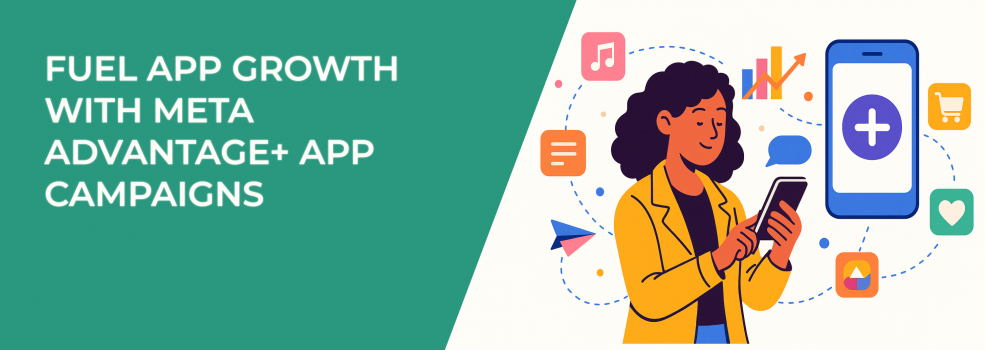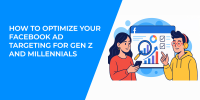If you promote a mobile app on Facebook or Instagram, you know how much time it takes to set up and manage campaigns. From selecting placements to writing ad copy and adjusting budgets, things can get complicated quickly.
Meta’s Advantage+ App Campaigns aim to fix that.
They offer a faster, more automated way to run ads that drive app installs and in-app actions — without needing to manage every detail manually.
In this article, we’ll break down what Advantage+ App Campaigns are, how they work, and what to focus on if you want better results with less effort.
What Are Advantage+ App Campaigns?
Advantage+ App Campaigns are a type of ad in Meta Ads Manager designed for mobile app promotion. They use automation to manage bidding, placements, and audience delivery. The main goal is to make setup easier and improve results by letting Meta’s system handle more of the work.
With Advantage+, you don’t need to choose specific interests or detailed targeting. You also don’t need to build separate ads for each audience. Instead, you focus on your creative assets, countries or regions you want to target, and your main goal — such as getting more installs or increasing in-app purchases.
It’s a simpler way to run app ads, especially if you don’t have a large team or a lot of time.
Faster Setup, More Campaign Options
Creating a campaign is faster with Advantage+. You can:
-
Upload up to 50 images or videos at once,
-
Combine different texts and headlines,
-
Automatically generate many ad versions from your creative.
This saves time and helps you test different messages or visuals without starting from scratch each time.
You can also run multiple campaigns for different goals. For example:
-
One campaign to get new installs,
-
Another to get people to complete a purchase,
-
A third to test different creative styles in a specific country.
Since Meta avoids showing the same ad to the same people across campaigns, you don’t have to worry about overlapping audiences.
Tip: avoid using the same event and country in multiple campaigns at the same time. This can reduce performance.
Audience Targeting: Less Manual Input, More Flexibility
Advantage+ doesn’t include detailed targeting options like interests or lookalike audiences. Instead, you only set:
-
Country or countries,
-
Language (optional),
-
App store platform (iOS or Android).
This limited targeting helps Meta show your ads to people more likely to install or engage with your app — even if they don’t match the usual audience filters.
It may feel strange to give up that level of control, but in many cases, the system can find valuable users you wouldn’t have found on your own.
Reporting: What You Can (and Can’t) See
Advantage+ doesn’t show performance by individual ad placements (like Stories or Reels). But you can still see breakdowns by:
-
Age,
-
Gender,
-
Country,
-
Device type,
-
Platform (Facebook, Instagram, Audience Network).
This helps you understand who is responding to your ads and how different devices or regions are performing.
Use this data to decide which creatives work best and where to adjust your campaigns in the future.
Creative Tips for Better Results
Since you can upload up to 50 assets per campaign, Advantage+ is ideal for testing different ad formats. Use a mix of:
-
Images and videos,
-
Playable ads,
-
Instant Experiences.
You can also upload multiple text and headline options. Meta will test combinations automatically and use the ones that perform best.
Tip: refresh your ad creative every 2–4 weeks to avoid showing the same content too often. This can help keep engagement and performance high.
Bidding and Budget Strategy
Advantage+ uses the lowest cost bid strategy. You can add a bid cap if you want to control your cost per result — but this can limit your reach and reduce the number of installs or events you get.
It’s usually better to start without a bid cap and monitor performance. Meta’s system will try to get the best results within your budget.
Choose the right optimization based on your goals:
If your goal is to get more app installs, use App Installs Optimization. This focuses on finding users likely to install your app, with cost per install as the key metric.
If you're aiming to increase link clicks, choose Link Clicks Optimization. It works with any audience targeting and is best measured by cost per link click.
If you want users to complete specific in-app events (like sign-ups, purchases, or registrations), go with App Events Optimization. Use this when your main KPIs are cost per event or ROAS.
If you're trying to maximize revenue or value per user, select Value Optimization. It’s designed to improve your return on ad spend (ROAS).
Choosing the right optimization helps Meta's system focus your budget on users most likely to take the action you care about. Stick to one clear goal per campaign for best results.
What You Can’t Do in Advantage+ App campaigns
There are a few limitations to keep in mind:
-
You can’t target by interest, gender, age (except minimum age), or device,
-
You can’t use custom or lookalike audiences,
-
You can’t select specific placements,
-
You can’t use traffic, engagement, or lead objectives.
Also, people who recently installed or opened your app (within 90 days) won’t see your ads again. This helps prevent wasted budget.
Should You Use Advantage+ App Campaigns?
If you're looking for a simple, more automated way to promote your app, Advantage+ is a strong option.
According to Meta, Advantage+ App campaigns show better overall results than manual campaigns. The question is, will it work the same for you?
It’s especially useful if:
-
You want to scale quickly without managing every detail,
-
You want to test a lot of creative combinations,
-
You’re focused on installs, in-app actions, or revenue.
However, if you need full control over targeting or want to use objectives like traffic or engagement, then the standard campaign types may still be a better fit.
Tip: try running an A/B test comparing Advantage+ to your current app campaign setup. This is the best way to see what works for your goals.
Best Practices for Running Advantage+ App Campaigns
To get the most out of Advantage+ App Campaigns, it’s important to use them the way they’re designed — simple setup, broad reach, and smart creative variation. While Meta’s automation handles many parts of the campaign, your input still plays a key role in overall success.
Here are some best practices to help you run campaigns more effectively:
1. Set Clear Goals for Each Campaign
Start by choosing the right optimization type based on what you want to achieve:
-
If you're focused on getting more installs, choose App Installs optimization.
-
If you want users to complete in-app actions like sign-ups or purchases, go with App Events.
-
If your goal is to maximize revenue, use Value Optimization to focus on return on ad spend (ROAS).
Make sure each campaign has a clear purpose. This also helps avoid overlapping audiences and keeps performance clean and measurable.
2. Keep the Bidding Simple
The only bid type available is lowest cost, and in most cases, it works well as-is. Adding a bid cap may seem like a good way to control costs, but it can also slow down delivery and reduce the number of results.
Unless you have a very specific cost-per-result target, it’s usually better to leave the bid cap off — especially in early tests.
3. Use Multiple Campaigns for Different Goals or Audiences
There’s no limit to how many Advantage+ App Campaigns you can run. This makes it easy to:
-
Run separate campaigns for different regions or countries.
-
Test creative variations for different events (like installs vs. purchases).
-
Promote multiple apps or product categories without overlap.
Meta Ads Manager also helps prevent campaign duplication by flagging repeated setups, so you don’t have to worry about making accidental copies.
To help campaigns reach stable performance sooner, here’s how to get through the learning phase more efficiently.
4. Upload Enough Creative — and Refresh Often
Since the system auto-generates ad combinations, give it more to work with:
-
Upload up to 50 images or videos in each campaign.
-
Include several versions of headlines and primary text.
-
Try playable ads or Instant Experiences for better engagement.
Refreshing your creative every few weeks helps avoid ad fatigue and keeps performance steady. Just avoid making changes too early — especially during the learning phase.
Tip: try uploading new creative in batches instead of replacing everything at once.
Not sure which creative types to use? This guide to Facebook ad formats shows the options available and how they perform.
5. Use Reporting to Inform Creative Strategy
Although you won’t get placement-level performance reports, Advantage+ still gives access to useful breakdowns, including:
-
Age and gender,
-
Device and platform,
-
Country,
-
Placement type.
Use this data to learn what’s working and update future campaigns. You can also see performance by creative unit — helping you understand which visuals and copy combinations drive results.
6. Avoid Audience Overlap
If two campaigns are targeting the same event in the same country, they could compete against each other — lowering performance across both. To avoid this:
-
Make sure each campaign has a unique combination of goals or countries.
-
Avoid running campaigns with similar targeting at the same time.
-
Use Meta’s A/B testing tools to run split tests before making big changes.
This approach gives clearer results and avoids wasting budget.
Final Thoughts
Advantage+ App Campaigns help advertisers simplify their setup, test more creative, and reach more valuable users. While you lose some manual controls, you gain speed, automation, and better use of Meta’s delivery system.
If your goal is to grow your app efficiently and reduce time spent managing ads, it’s worth trying this campaign type — even if for a limited test.
Looking to scale your campaigns without losing results? This article on scaling Facebook ads offers clear strategies that work well with Advantage+.

